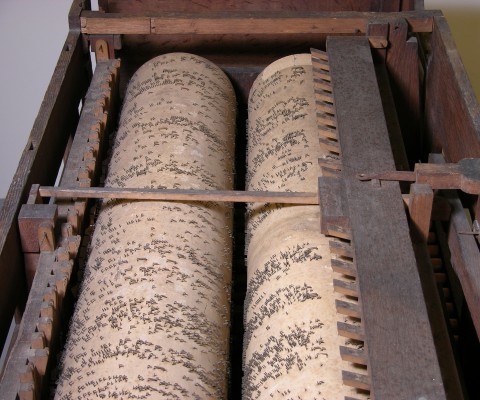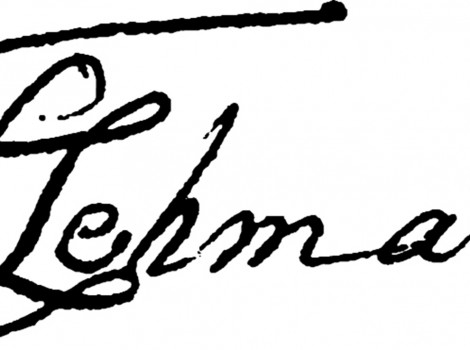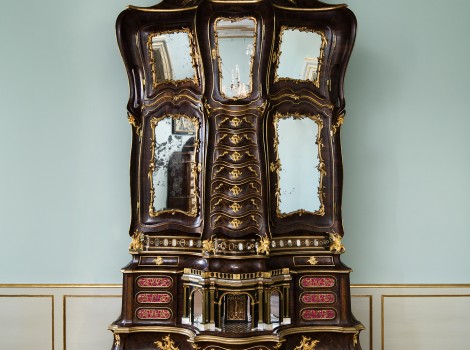C. F. Lehmann’s ”Musical Cabinet”
The restoration of the large rococo item of furniture “Lehmann’s Musical Cabinet”, produced by C. F. Lehmann in 1757, has led to a fascinating research collaboration with Curator Ture Bergstrøm from The Museum of Music/The National Museum of Denmark, in order to find and recreate the music which the cabinet played in the mid-1700s.
Conservation Technician Tom Feilberg and Ture Bergstrøm have developed a system for decoding the cabinet’s musical cylinders, as the mechanism was so damaged that it couldn’t be recreated without the loss of important musicological information. On the cylinder for the trumpet piece, which is controlled by a hidden clock (with striking mechanism), there are 7 fanfares, and in the large musical box, which works with two synchronously rotating cylinders, there are 14 pieces of music for flute and cembalo. All the cylinders have been digitally measured and decoded with a laser camera. The results have been corrected in relation to measurable errors in the cylinders, for example ovality, crooked pins, and cracks in the wood. After this the results were converted into digital sound files, which thus revealed music which hadn’t been heard since the time of Frederik V. Following conversion into actual music, it has been possible, using the soundscape, to correct mistakes which had not been measurable.
The final step in the process was to have professional sound recordings made of everything in the musical box which originally made a sound. The flautist Winnie Bugge Frendsen has played all 24 flutes, and the organ builders Frobenius have sounded all the organ pipes (the trumpets). Sound engineer Simon Tamdrup made all the recordings, including of the striking mechanism’s clock and all sorts sounds made by the mechanism. The cembalo is missing but the notes are known. Using the tuning of the flute (the concert pitch = 413 Hz) Simon Tamdrup has retuned recordings of a contemporary cembalo from southern Germany, so that this sound is also convincing.
All of these recordings have now been sampled into the decoding of the cylinders, so that it is possible to recreate the original soundscape of “Lehmann’s Musical Cabinet”. The music and the coding work were presented at an international congress for musicologists on 28 August (CIMCIM Conference 2014).
Ture Bergstrøm subsequently described the research project in “The Galpin Society Journal” in an article entitled “The Music of the C. F. Lehmann Kunstschrank at Rosenborg Castle, Copenhagen”. In this article the music is described in detail in the context of musicology with reference to the audio examples below.
In all 21 pieces of music – including 14 recreated from the flute mechanism and 7 recreated from the trumpet mechanism – can be enjoyed in three different versions using the links below:
The directly decoded music (primarily for researchers / people with a particular interest)
The music edited by Ture Bergstrøm (primarily for researchers / people with a particular interest)

 Dansk
Dansk
 English
English
 Deutsch
Deutsch



